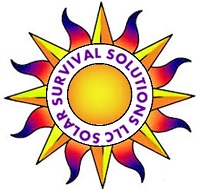Thank you for visiting Solar Survival Solutions
We help you be prepared!
The sun is a star. A star does not have a solid surface, but is a ball of gas (92.1 percent hydrogen (H2) and 7.8 percent helium (He)) held together by its own gravity.
The sun is the center of our solar system and makes up 99.8% of the mass of the entire solar system.
If the sun were as tall as a typical front door, Earth would be about the size of a nickel.
Since the sun is not a solid body, different parts of the sun rotate at different rates.
At the equator, the sun spins once about every 25 Earth days, but at its poles the sun rotates once on its axis every 36 days.
The solar atmosphere is where we see features such as sunspots and solar flares on the sun.
The sun’s outer atmosphere — the corona — extends beyond the orbit of dwarf-planet Pluto.
The sun is orbited by eight planets, at least five dwarf planets, tens of thousands of asteroids, and hundreds of thousands to three trillion comets and icy bodies.
The sun does not have any rings.
Spacecraft are constantly increasing our understanding of the sun — from Genesis (which collected samples of the solar wind and returned the particles to Earth) to SOHO, STEREO THEMIS, and many more, which are examining the sun’s features, its interior and how it interacts with our planet.
Without the sun’s intense energy there would be no life on Earth.The temperature at the sun’s core is about 15 million degrees Celsius (27 million degrees Fahrenheit).
The words solar system refer to the sun and all of the objects that travel around it — planets, natural satellites such as the moon, asteroid belt, comets, and meteoroids. Our solar system is part of a spiral galaxy known as the Milky Way.
The sun, the center of our solar system, holds eight planets and countless smaller objects in its orbit.
Our solar system is made up of the sun and everything that travels around it. This includes eight planets and their natural satellites such as Earth’s moon; dwarf planets such as Pluto and Ceres; asteroids; comets and meteoroids.
The sun is the center of our solar system. It contains almost all of the mass in our solar system and exerts a tremendous gravitational pull on planets and other bodies.
Our solar system formed about 4.6 billion years ago.
The four planets closest to the sun — Mercury, Venus, Earth, and Mars — are called the terrestrial planets because they have solid, rocky surfaces.Two of the outer planets beyond the orbit of Mars — Jupiter and Saturn — are known as gas giants; the more distant Uranus and Neptune are called ice giants.Most of the known dwarf planets exist in an icy zone beyond Neptune called the Kuiper Belt, which is also the point of origin for many comets.
Many objects in our solar system have atmospheres, including planets, some dwarf planets and even a couple moons.
Our solar system is located in the Orion Arm of the Milky Way Galaxy.
There are most likely billions of other solar systems in our galaxy. And there are billions of galaxies in the Universe.
We measure distances in our solar system by Astronomical Units (AU). One AU is equal to the distance between the sun and the Earth, which is about 150 million km (93 million miles).
http://solarsystem.nasa.gov/planets/profile.cfm?Object=Sun
http://solarsystem.nasa.gov/planets/index.cfm

